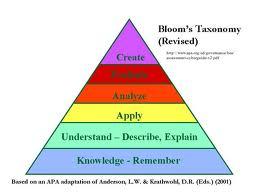Dictionary Definition of Education:
"1. The act or process of educating or being educated.
2. The knowledge or skill obtained or developed by a learning process.
3. A program of instruction of a specified kind or level: driver education; a college education.
4. The field of study that is concerned with the pedagogy of teaching and learning.
5. An instructive or enlightening experience: Her work in the inner city was a real education"
(Education, 2013).
My Working Definition of Education: The process by which the students gain skills and knowledge. This is a process in which the students are actively engaged and constructing their own knowledge. It is my job to facilitate their learning and scaffold them so that they can achieve more.
Scaffolding: Providing support to students so that they can achieve more than they could on their own.
Zone of Proximal Development: The range of skills of which a child is capable. The lower range represents the skills which the child can achieve on his own. The upper range represents the skills which are beyond the child's developmental capabilities. The middle range represents the skills which the child can achieve with scaffolding from a more knowledgeable other.
Safe: I seek to create an environment where it is okay to fail as long as the students are trying. I want them to know that we often learn the most by failing. I do, however, expect the students to learn from their mistakes and work to correct and overcome them. I will partner with the students who are actively seeking solutions and knowledge.
Nurturing: I seek to create an atmosphere in which the students feel accepted and free to try new things. This also includes an atmosphere of mutual respect, between teacher and students, and between student and other students.
Critical Thinking: The process by which students think reflectively and productively while they consider the facts and situations they encounter.
Mindfulness: The process where by a student is actively engaged and mentally flexible as he/she goes throughout life. This includes being proactive in his/her education. This is an important part of critical thinking.
Cooperative Learning: A teaching/learning technique in which students work in small groups in order to engage in the learning process. This is a great way to meet the multiple learning style needs within the classroom.
Disequilibrium: the idea that exposure to a new idea or concept creates a sense of imbalance in the learners which causes a mental struggle or discomfort.
Equilibrium: The resolution of disequilibrium when a student incorporates the new information into his way of thinking. This results in a new sense of mental balance.
Bloom's Taxonomy: A hierarchy of skills created to help teachers to challenge their students to achieve more. The higher levels of Bloom's represent higher levels of critical thinking.
(Education, 2013).
My Working Definition of Education: The process by which the students gain skills and knowledge. This is a process in which the students are actively engaged and constructing their own knowledge. It is my job to facilitate their learning and scaffold them so that they can achieve more.
Scaffolding: Providing support to students so that they can achieve more than they could on their own.
Zone of Proximal Development: The range of skills of which a child is capable. The lower range represents the skills which the child can achieve on his own. The upper range represents the skills which are beyond the child's developmental capabilities. The middle range represents the skills which the child can achieve with scaffolding from a more knowledgeable other.
Safe: I seek to create an environment where it is okay to fail as long as the students are trying. I want them to know that we often learn the most by failing. I do, however, expect the students to learn from their mistakes and work to correct and overcome them. I will partner with the students who are actively seeking solutions and knowledge.
Nurturing: I seek to create an atmosphere in which the students feel accepted and free to try new things. This also includes an atmosphere of mutual respect, between teacher and students, and between student and other students.
Critical Thinking: The process by which students think reflectively and productively while they consider the facts and situations they encounter.
Mindfulness: The process where by a student is actively engaged and mentally flexible as he/she goes throughout life. This includes being proactive in his/her education. This is an important part of critical thinking.
Cooperative Learning: A teaching/learning technique in which students work in small groups in order to engage in the learning process. This is a great way to meet the multiple learning style needs within the classroom.
Disequilibrium: the idea that exposure to a new idea or concept creates a sense of imbalance in the learners which causes a mental struggle or discomfort.
Equilibrium: The resolution of disequilibrium when a student incorporates the new information into his way of thinking. This results in a new sense of mental balance.
Bloom's Taxonomy: A hierarchy of skills created to help teachers to challenge their students to achieve more. The higher levels of Bloom's represent higher levels of critical thinking.


